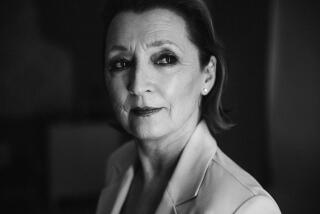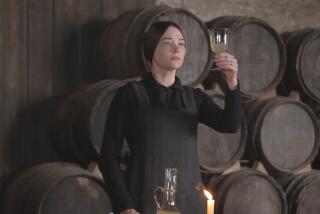Bertrand Tavernier goes back in time with ‘The Princess of Montpensier’
- Share via
Veteran French filmmaker Bertrand Tavernier (“A Sunday in the Country,” “Life and Nothing But,” “’Round Midnight”) has a simple philosophy when it comes to making period pieces — just because the film is set in the past, that doesn’t mean the characters should be living in the past.
But Tavernier admits achieving his philosophy was something of a balancing act in the case of his latest movie, the swashbuckling romantic drama “The Princess of Montpensier,” which opened Friday. Set in 1562 during the Catholic-Protestant wars in France, “Princess” revolves around the teenage aristocrat Marie (Melanie Thierry), who is in love with the dashing and ambitious Henri de Guise (Gaspard Ulliel). But she is forced by her father to marry a man she doesn’t know, the prince of Montpensier (Gregoire Leprince-Ringuet). When the prince is called away to battle, he leaves her in the care of his mentor and best friend, the aging Count Chabannes (Lambert Wilson), who, like De Guise and the prince, finds himself in love with the beautiful, independent-minded Marie.
“I didn’t want to shoot a museum piece,” said the 69-year-old filmmaker by phone from his home in Paris. “I have seen films be ponderous when they look at the past. I had to film them living in the present. But at the same time, the way they were behaving had to be accurate.”
Clothes sense
Tavernier remembered what the legendary Jean Renoir once said about period pieces: “In those films can easily be detected who are comfortable in their clothes and the ones who are not. All my actors who were comfortable, they knew how to wear them.”
It became an obsession for him to find actors who would be comfortable inhabiting the 16th century. “I made many tests before finding Melanie,” he says. “There were many good actresses who could maybe be terrific in modern parts, but they looked like they were disguised in those dresses. It was not organic, and they didn’t know how to speak the language, which was not the modern, simplistic language of today. It is more complicated, more musical. Melanie has an ease.”
The film, though, is stolen by Wilson, first seen in 1977’s “Julia” and currently in the award-winning French drama “Of Gods and Men.”
“He is a very good rider and was completely at ease in the character,” Tavernier said. “He was absolutely perfect for the past. There were many people who were both men of action and men of culture. You can easily believe he is both.”
And one can easily believe that he is in love for the first time and doesn’t know how to deal with his passion for Marie. “He is discovering love when he was not expecting it, and he is torn like most of the other characters in the film between their passion and their duties,” said Tavernier. “He is falling in love with his best friend’s wife and not only is he his friend, he is someone who is protecting him. So that love is incredibly passionate, but it is filled with a lot of guilt.”
The day after Tavernier screened “Princess” for Wilson, he received a letter from the actor. “It is one of the most beautiful letters,” Tavernier said. “He said that when I took the improbable job of acting it was with the secret hope that one day I would act in a film like the one I saw tonight.”
Swordplay not a problem
Tom Luddy, co-founder of the Telluride Film Festival, has been friends with Tavernier for nearly 40 years. He admits he was surprised when he heard Tavernier was making a romantic swashbuckler. “When we were young, Bertrand and me, there were wonderful films like ‘Scaramouche’ and ‘Robin Hood’ — those great swashbucklers set in castles with princesses and swordplay. I was worried when I heard he was doing this film. It was hard for me to imagine that he would be able to pull off something with the kind of great swordplay that we had in the Hollywood films, and he did.
“For women to come out of the screening saying, ‘He reminded me of Errol Flynn’ — he really pulled off something splendid. When he told me that he made the film in something like 36 days, it was astounding to me,” Luddy said.
The Lyon-born Tavernier fell in love with movies when he was a boy. He quit law school to write film criticism for Cahiers du Cinema, the French film magazine the founders of the New Wave movement including Francois Truffaut and Jean-Luc Godard began before they made movies. Tavernier still writes a blog reviewing American DVDs and has written countless books in French on U.S. cinema.
“He is one of the world’s great film buffs,” Luddy said. “He is a fountain of lore and history about film. This past year when I drove to Telluride [from San Francisco], he was in the car. He likes to drive to Telluride with me through the Southwest. We had Stephen Frears in the car, and it was a nonstop seminar in film history. Sometimes he settles down and makes a few good films!”
Tavernier was a film publicist and also worked as an assistant director to Jean-Pierre Melville on “Leon Morin, Pretre” before making his first feature, 1974’s “The Clockmaker of St. Paul” with Philippe Noiret, with whom Tavernier worked several more times.
The late Noiret, said Tavernier, “was one of the most lovely men in the world. I owe him my career. He believed in me when nobody else would. He stood by me for two years when the film was rejected. I said, ‘Philippe, I can understand you are with me for nine months, but two years?’ He said, ‘Bertrand, I gave you my word.’”
More to Read
The biggest entertainment stories
Get our big stories about Hollywood, film, television, music, arts, culture and more right in your inbox as soon as they publish.
You may occasionally receive promotional content from the Los Angeles Times.











